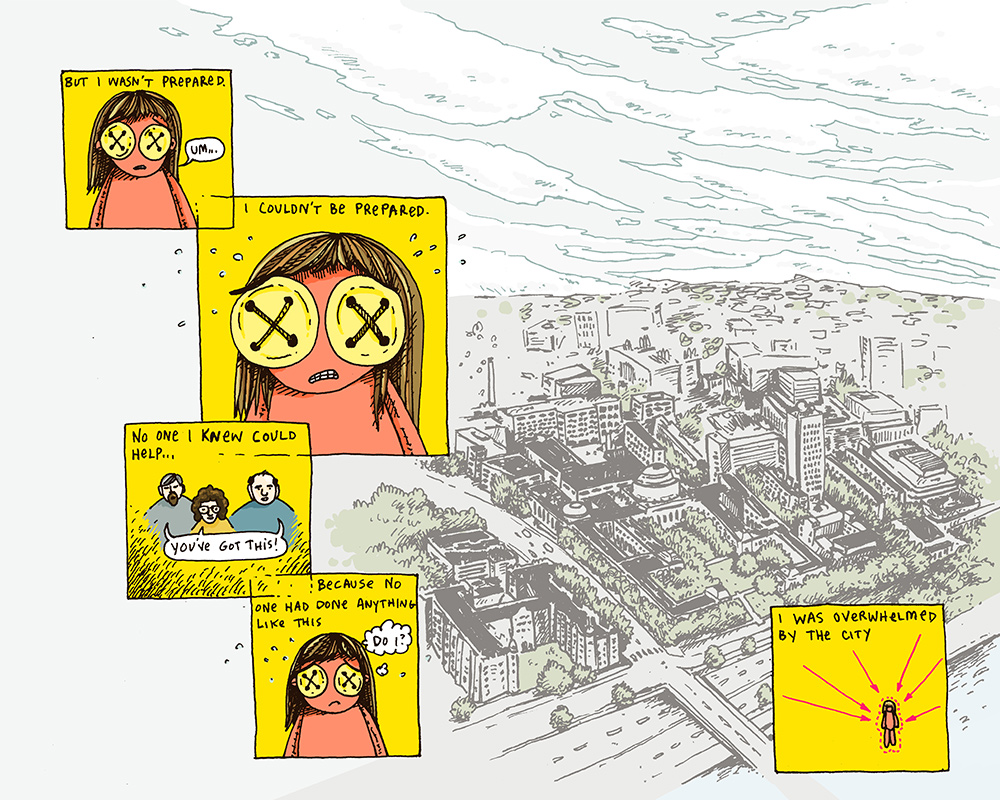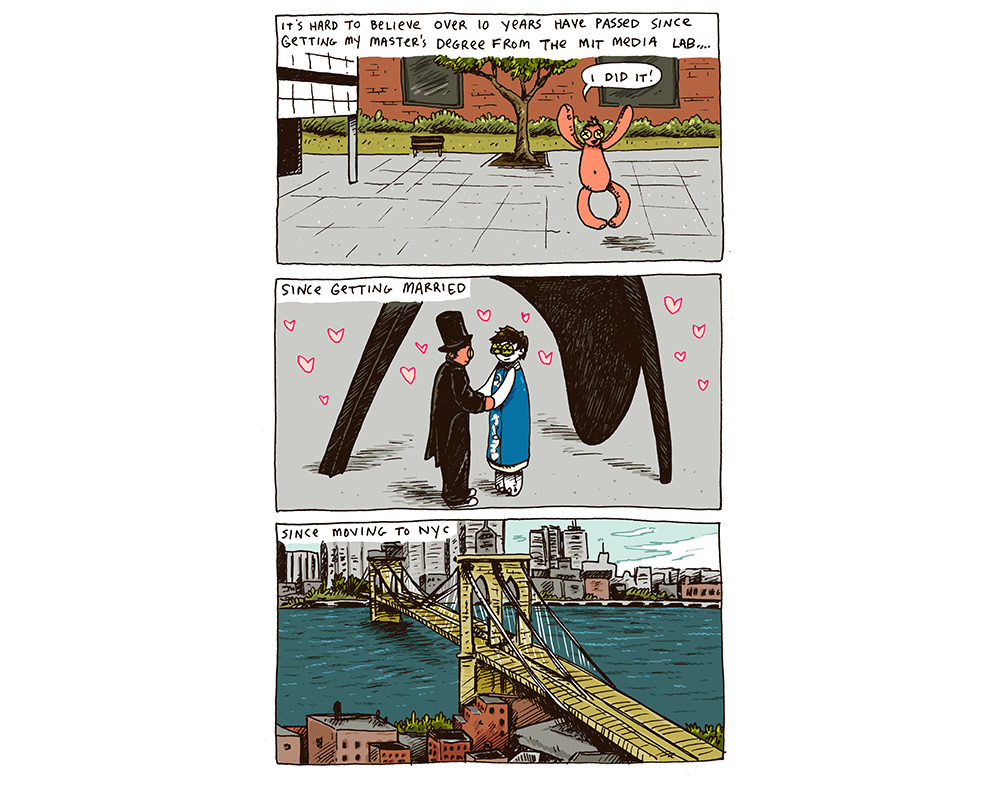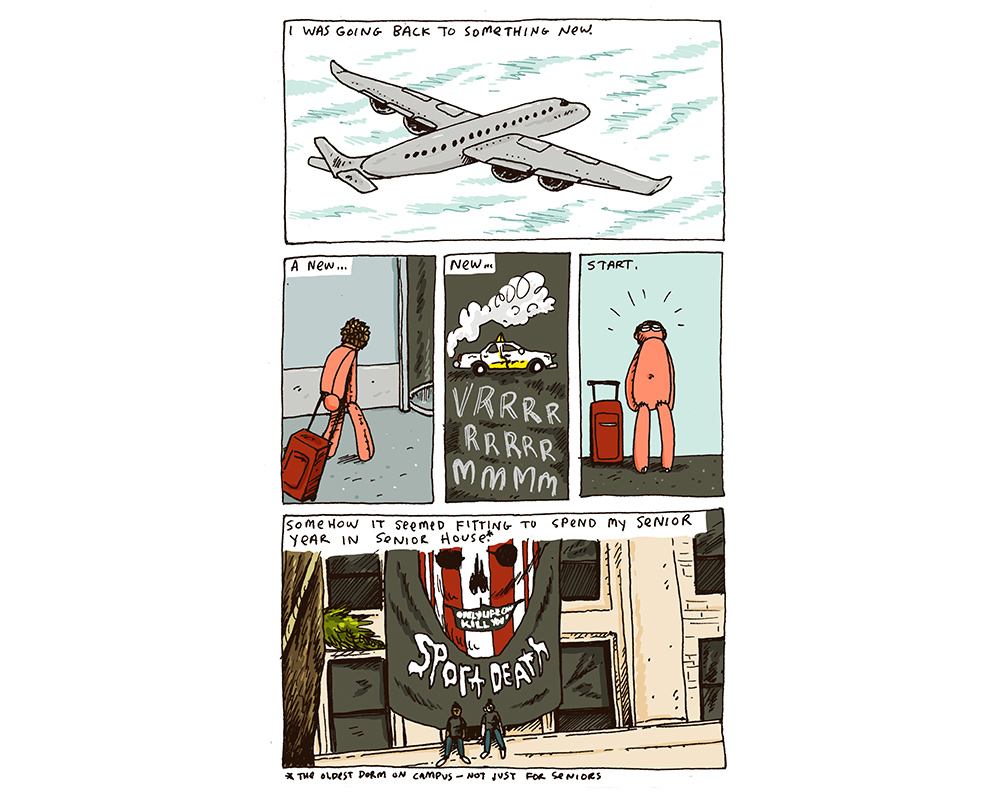L. Nichols will present a reading of his new work “Flocks,” an autobiographical graphic novel, on Tuesday, November 27, 2018 from 5:00-6:15pm in the MIT Wiesner Student Art Gallery. The reading will include an introduction by Stephen Tapscott, Professor, Literature and will be followed by a Q&A with Azra Akšamija, Associate Professor, ACT and L. Nichols. This event is free and open to the public; no registration necessary.
Transgender artist L. Nichols ’05 & SM ’07 looks at MIT’s powerful influence on his life and art
Growing up transgender in a conservative Christian family in rural Louisiana didn’t allow much room for self-expression. Pretty much everything was tightly buttoned-up.
Now the buttons are off. Council of the Arts at MIT (CAMIT) member L. Nichols ’05 & SM ’07 has transformed those painful early experiences into Flocks, his autobiographical graphic novel.
Nichols first took up his drawing pencil while studying Mechanical Engineering at MIT, inspired by former MIT Director of Comparative Media Studies Program and the Peter de Florez Professor of Humanities Henry Jenkins (who currently serves as the Provost’s Professor of Communication, Journalism, and Cinematic Arts at the University of Southern California.) Nichols later went on to receive a Master’s degree in Media Arts and Sciences.
This transition, like so many others Nichols has undertaken (including those involving gender assignment and identity) has shaped his life and perspective and enriched his work.

The Journey from Louisiana to MIT
“I grew up in a town of approximately 3,000 people,” recalls Nichols, who saw the isolation as the worst part of his upbringing. “Almost everyone in the town was religious to some degree or another.”
Career alternatives were limited. Most of Nichols’ childhood neighbors were involved in the local oil or timber industries. Women worked mostly in education or nursing.
“There were very few examples of the type of life you could possibly lead,” he explains. “I couldn’t imagine having a life like any of the people around me.”
It was especially difficult being part of the LGBTQ community in a place where such things were not discussed, let alone accepted, recalls the artist. “It further added to my sense of isolation and distance from those around me.” Not surprisingly, Nichols had been planning his escape from rural life for some time. And MIT was central to his plan.
“I wanted to go to MIT since I was 10 or 11 years old,” he remembers. Noting that he often built model rockets with his mechanic father and played with a chemistry set as a child, Nichols cites science as a “favorite” subject.
While his move to Cambridge surprised many in his Louisiana community, he was amazed by the newfound skills and passion he discovered at MIT.
“Becoming an artist was…a surprise for me,” Nichols admits, “and not at all what I had planned.” He was the first in his immediate family to finish college.
Today, Nichols puts his eclectic talents to use across mediums: as illustrator and cartoonist for various publications, as painter of murals and commercial windows and as co-publisher of the comics quarterly, Ley Lines. He also serves as a teaching artist at New York’s 92nd Street Y and currently runs STEAM, a Brooklyn-based program that offers STEM-focused workshops in art and design to young teens. In between these ventures, he finds time to build and “upcycle” furniture, create kinetic sculpture and design jewelry.
His latest projects explores the idea of memory and loss through a series of cyanotype prints.

A Visual Language that Speaks for Itself
As so much of what he does borders the alleged line between them, Nichols sees the “science vs. art” divide as “a false dichotomy” and maintains that both are intrinsically “tied to the drive to explore and create.” His love of both art and science have led him to incorporate vectors and equations into his artistic endeavors.
For Flocks, Nichols created a visual palette that drew from his psyche.
“I’ve always liked drawing little dolls and stuffed animals. While living in Cambridge, I realized I was giving one doll in particular my haircut and piercings. I had been drawing myself.”
Using the doll figure in Flocks made dealing with a difficult subject “more approachable,” says Nichols, explaining that his stuffed avatar’s interactions with “real” humans offers “a level of visual disconnect that otherwise might have to be explicitly stated.”
Just as he was drawn to paternal “learning games,” Nichols is grateful for Professor Jenkins’ inspired teaching; he remains his artistic muse to this day. “His classes still influence the way I approach comics.”
It was also at MIT that Nichols first felt a sense of community and where he met his wife. “MIT literally gave me the family I have now,” he muses.
His time on campus connected him to others in the field, many of whom inspired Flocks and other works. “It was the influence of my friends,” says Nichols, who especially appreciates the people he met while living in England as part of the Cambridge-MIT Exchange and in Senior House. “They encouraged me and supported me. They were the reason I started self-publishing and pursued my art. They made me believe in myself.”
An Advocate for the Arts Community at MIT
Given the profound impact that MIT has had on his life, Nichols remains in close contact with his MIT community. He also serves as an associate member of the Council of the Arts. “I enjoy sitting on the grants committees,” Nichols laughs, “and always try to advocate for the students.”
As a recipient of the Laya and Jerome B Wiesner Student Art Award (given out by the Council), Nichols wanted to show his appreciation and give back to the MIT arts community.
“It was the art award that gave me enough money to buy better supplies and start pursuing art more diligently,” Nichols recalls. “A large part of the reason I’m involved with the Council is because I remember how influential and relieving even a small gift and nod of support can be to an artist.”
Now that he’s completed the monumental task of translating a difficult upbringing into a graphic novel, Nichols is ready to scale new heights, those of a more physical nature. The endeavor is likely to call on his studies in mechanical engineering.
“I am working on hiking the high peaks in the Catskills and doing a series of drawings for each hike,” Nichols says, pointing interested parties to the website. “I’m also working on setting up my blacksmith and metalwork workshop so I can start working on some larger sculpture projects. Just getting that studio set up is a project in itself!”


